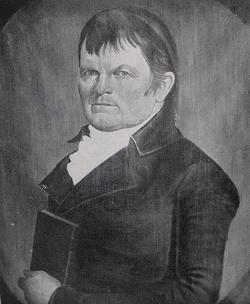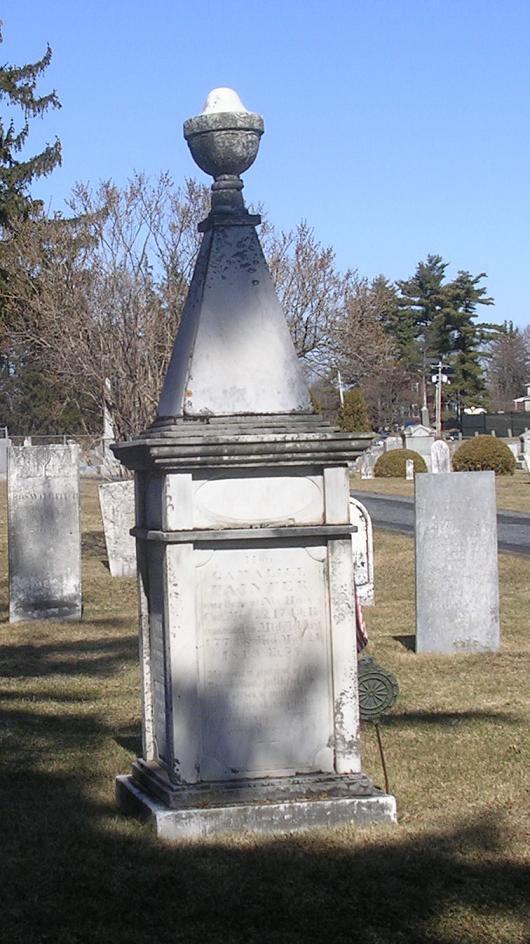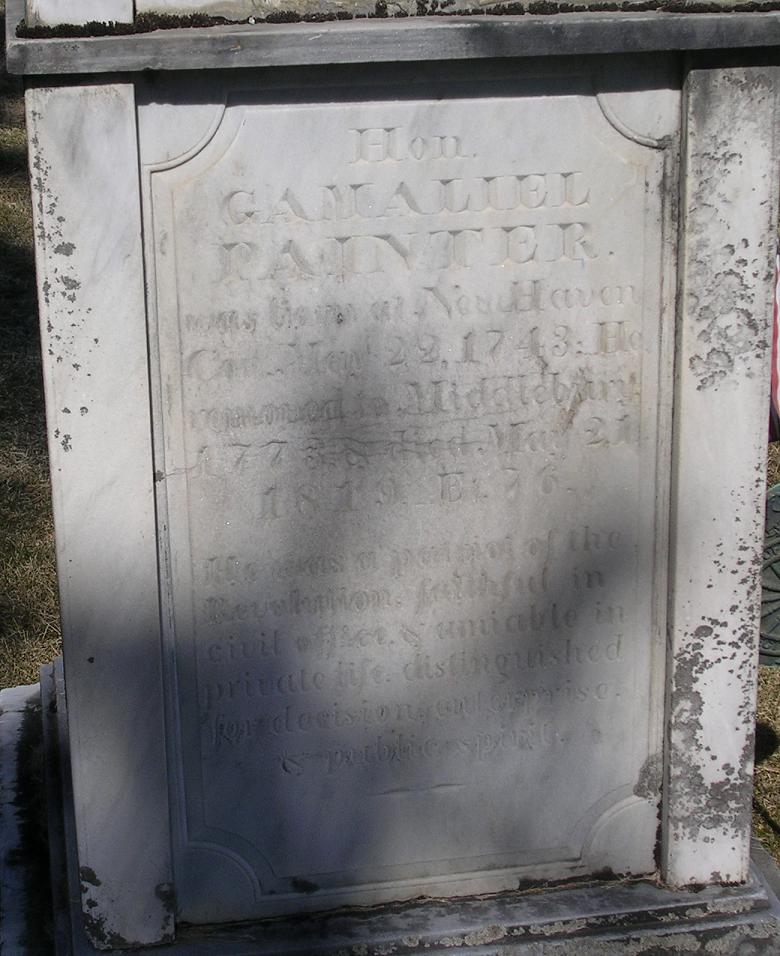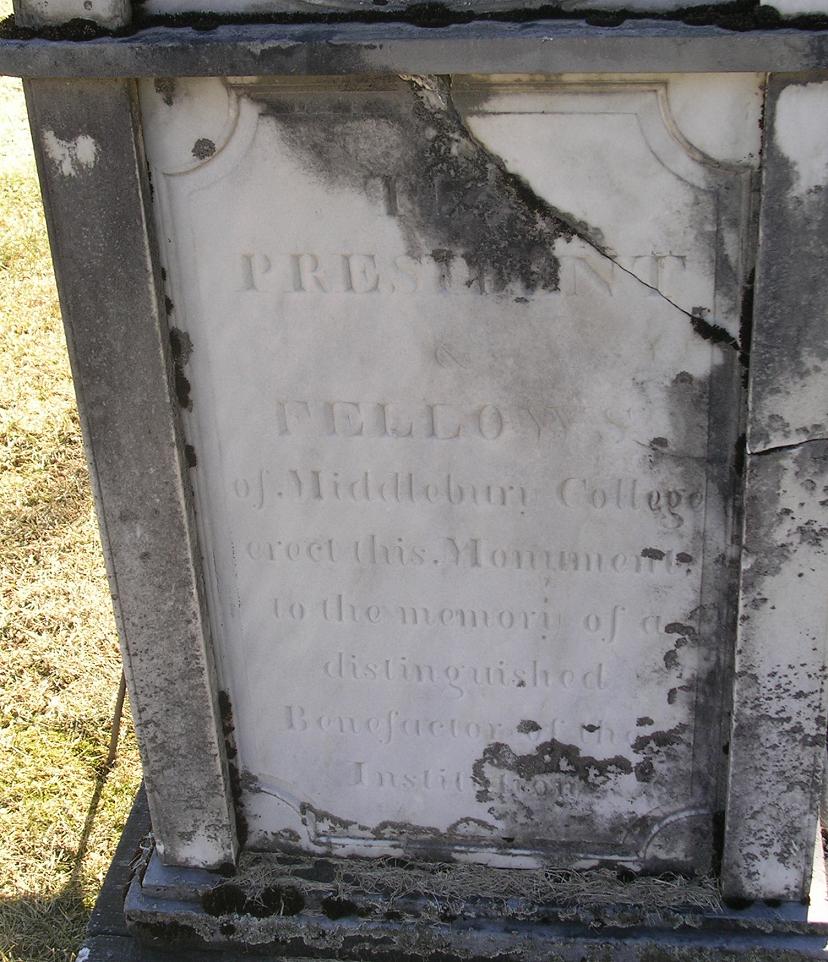Gamaliel was the last of 6 children (3rd son) born of Shubael Painter and his wife Elizabeth Dunbar. Gamaliel's siblings were: Joseph (b. 1731), Rebeckah (b. 1734), Elisha (b. 1736), Lydia (b. 1739), and Sarah (b. 1742).
Gamaliel (Gamaleel) married, August 20, 1767, at Salisbury, Litchfield County, Colony of Connecticut, Abigail Chipman (1749-1790) by whom he had 2 children (both sons): Joseph (1770-1804) and Samuel (1772-1797).
Gamaliel came to Middlebury, on the New Hampshire Grants (later Addison County, Vermont) with his brother-in-law John Chipman in 1773. Gamaliel became a large property holder in the town, and subsequently did much towards establishing the growth of the village, being very generous in his donations of land for village and college purposes.
The Continental Congress resolved, July 5, 1776, that a Regiment be raised for the 1776 Campaign out of the officers who served in Canada and that the following persons be appointed officers of the said Regiment: Seth Warner, Colonel; Samuel Safford, Lieutenant Colonel; Elisha Painter,3 Major and Gamaliel Painter, First Lieutenant; etc.
On September 24th and 25th, 1776, Gamaliel, as the Delegate from Middlebury, attended a general convention of Town Committees responsible for, when the occasion required, the common defense and welfare of their respective communities. The convention was held at the house (tavern) of Cephas Kent in Dorset. Here it was resolved "to take suitable measures as soon as may be, to declare the New Hampshire Grants a separate district." This was the germ that soon expanded and grew into the free and independent state of Vermont. On July 2, 1777, He was a member of the convention which founded the Vermont State Constitution.
Following the British retaking Fort Ticonderoga on July 7, 1777 and thru the year 1778, the Americans retreated to places to the south, the whole country opposite being exposed to foraging and marauding parties of British, Indians, and Tories. A great portion of the early permanent settlers in the territory, took up arms and fought bravely for their homes and freedom, while their families moved farther south to places of greater safety. Those that chose to remain on their farms were taken prisoner by the enemy. Gamaliel, though driven from his home, did not leave Vermont till the British had gained a dangerous control over all western Vermont.
Gamaliel, having returned to Salisbury, Litchfield County, Connecticut, was commissioned Captain, July 21, 1777, and commanded a Company of men from Connecticut in a Continental Corps of Artificers commanded by Colonel of Engineers and Lieutenant Colonel Commandant of Artificers Jeduthan Baldwin of Massachusetts. The Corps was under the direction of the Quartermaster General and its duties were those attached to a pioneer and construction Corps. The men were largely artisans, carpenters, builders, tent makers, tailors, etc. The Regiment was at Brandywine, Germantown, and Monmouth. Gamaliel continued in this capacity to the end of the War.
After the close of the war, in 1783, the former settlers of Middlebury gradually returned to their possessions. In 1784, Gamaliel returned with his family.
On the organization of Addison County, Vermont in 1785, the towns of Addison and Colchester were established as half shires, by the same act the County Court was set to meet at Addison on the first Tuesday of March and at Colchester on the second Tuesday in November. The 1st term of the Addison County Court met at Addison on the 1st Tuesday of March, 1786 with John Strong of Addison Chief Judge, Gamaliel Painter of Middlebury and Ira Allen of Colchester, Side or Assistant Judges. Gamaliel continued in this office 8 years.
The Town of Middlebury was organized and it's 1st meeting was held, March 29, 1786. Gamaliel was then elected the Town's 1st Representative to the Vermont General Assembly. He was town Representative 14 years.
In 1786, Gamaliel purchased 50 acres adjoining the falls and moved from his farm into the village and at once set out to make it the county seat. Here be built a saw-mill in 1787 and a gristmill in 1788. In 1791, he deeded the land, one acre and 65 rods "for the express purpose of erecting a court house and jail thereon, and as a common, never to be divided or put to any other use" where the construction of the court house was begun in 1796, completed and 1st occupied in 1798. In 1814, for various reasons it was deemed necessary to the court house to a new location. The new site was deeded to the County by Gamaliel "for the express purpose of erecting, keeping and having a court house for the county of Addison, on said premises, where the same is now erected, so long as the premises shall be used for the purpose aforesaid and no longer."
On November 8, 1787, a Grammar School was established in the village. Gamaliel was appointed 1st trustee.
In the 1790 US Census (taken in Vermont since in 1791), Gamaliel was enumerated as a Head of a Family with 3 Free White Males of 16 years of age and upwards and 1 Free White Female. Gamaliel's 1st wife Abigail died in 1790. For his 2nd wife he married Victoria Ball (1760-1806) by whom he had 1 daughter: Abby Victoria (1796-1818).
Middlebury College was founded in the year 1800. Gamaliel was a liberal contributor towards its erection, being one of its original trustees, and at his death he left the institution several thousand dollars in his will which realized a sizeable gift in its day. He was also deeply interested in the erection of the Congregational church, being appointed superintendent of the work.
After his 2nd wife Victoria died in 1806, he married Mrs. Ursula Ball (1747-1824).
References:
(1) New Haven, Connecticut Birth, Marriages & Deaths Vol. I. 1649-1750, pages 229, 230 and 237
(2) "Connecticut Vital Records Salisbury Births - Marriages - Deaths 1741-1846 Barbour Collection Connecticut State Library 1927" pages 26 and 88
(3) "Gazetteer and Business Directory of Addison County, VT., for 1881-82" by Hamilton Child, 1882, pages 27, 41, 49-51, 130, 134, and 138-143
(4) "The State of Vermont Rolls of the Soldiers in the Revolutionary War 1775 to 1783" by John E. Goodrich, 1904, pages 836 and 837
(5) "The Vermont Historical Gazetteer: A Magazine, Embracing A History of each Town, Civil, Ecclesiastical, Biographical and Military." Vol., by Abby Maria Hemenway, 1867, pages 50-53 and 58
(6) "The Record of Connecticut Men in the Military and Naval Service during the War of the Revolution 1775-1783." by Henry P. Johnston, 1889, page 289
(7) "History of the Congregational Church of Middlebury, VT. 1790-1913" by The Pilgrim Press, 1913, pages 54, 55 and 60
(8) Mss. Vermont Vital Records, Vermont Records Center, Middlesex, Washington County, Vermont
(9) Columbian Register (New Haven, CT) Saturday, March 20, 1824, Vol. XII, Issue 591, page 3
Gamaliel was the last of 6 children (3rd son) born of Shubael Painter and his wife Elizabeth Dunbar. Gamaliel's siblings were: Joseph (b. 1731), Rebeckah (b. 1734), Elisha (b. 1736), Lydia (b. 1739), and Sarah (b. 1742).
Gamaliel (Gamaleel) married, August 20, 1767, at Salisbury, Litchfield County, Colony of Connecticut, Abigail Chipman (1749-1790) by whom he had 2 children (both sons): Joseph (1770-1804) and Samuel (1772-1797).
Gamaliel came to Middlebury, on the New Hampshire Grants (later Addison County, Vermont) with his brother-in-law John Chipman in 1773. Gamaliel became a large property holder in the town, and subsequently did much towards establishing the growth of the village, being very generous in his donations of land for village and college purposes.
The Continental Congress resolved, July 5, 1776, that a Regiment be raised for the 1776 Campaign out of the officers who served in Canada and that the following persons be appointed officers of the said Regiment: Seth Warner, Colonel; Samuel Safford, Lieutenant Colonel; Elisha Painter,3 Major and Gamaliel Painter, First Lieutenant; etc.
On September 24th and 25th, 1776, Gamaliel, as the Delegate from Middlebury, attended a general convention of Town Committees responsible for, when the occasion required, the common defense and welfare of their respective communities. The convention was held at the house (tavern) of Cephas Kent in Dorset. Here it was resolved "to take suitable measures as soon as may be, to declare the New Hampshire Grants a separate district." This was the germ that soon expanded and grew into the free and independent state of Vermont. On July 2, 1777, He was a member of the convention which founded the Vermont State Constitution.
Following the British retaking Fort Ticonderoga on July 7, 1777 and thru the year 1778, the Americans retreated to places to the south, the whole country opposite being exposed to foraging and marauding parties of British, Indians, and Tories. A great portion of the early permanent settlers in the territory, took up arms and fought bravely for their homes and freedom, while their families moved farther south to places of greater safety. Those that chose to remain on their farms were taken prisoner by the enemy. Gamaliel, though driven from his home, did not leave Vermont till the British had gained a dangerous control over all western Vermont.
Gamaliel, having returned to Salisbury, Litchfield County, Connecticut, was commissioned Captain, July 21, 1777, and commanded a Company of men from Connecticut in a Continental Corps of Artificers commanded by Colonel of Engineers and Lieutenant Colonel Commandant of Artificers Jeduthan Baldwin of Massachusetts. The Corps was under the direction of the Quartermaster General and its duties were those attached to a pioneer and construction Corps. The men were largely artisans, carpenters, builders, tent makers, tailors, etc. The Regiment was at Brandywine, Germantown, and Monmouth. Gamaliel continued in this capacity to the end of the War.
After the close of the war, in 1783, the former settlers of Middlebury gradually returned to their possessions. In 1784, Gamaliel returned with his family.
On the organization of Addison County, Vermont in 1785, the towns of Addison and Colchester were established as half shires, by the same act the County Court was set to meet at Addison on the first Tuesday of March and at Colchester on the second Tuesday in November. The 1st term of the Addison County Court met at Addison on the 1st Tuesday of March, 1786 with John Strong of Addison Chief Judge, Gamaliel Painter of Middlebury and Ira Allen of Colchester, Side or Assistant Judges. Gamaliel continued in this office 8 years.
The Town of Middlebury was organized and it's 1st meeting was held, March 29, 1786. Gamaliel was then elected the Town's 1st Representative to the Vermont General Assembly. He was town Representative 14 years.
In 1786, Gamaliel purchased 50 acres adjoining the falls and moved from his farm into the village and at once set out to make it the county seat. Here be built a saw-mill in 1787 and a gristmill in 1788. In 1791, he deeded the land, one acre and 65 rods "for the express purpose of erecting a court house and jail thereon, and as a common, never to be divided or put to any other use" where the construction of the court house was begun in 1796, completed and 1st occupied in 1798. In 1814, for various reasons it was deemed necessary to the court house to a new location. The new site was deeded to the County by Gamaliel "for the express purpose of erecting, keeping and having a court house for the county of Addison, on said premises, where the same is now erected, so long as the premises shall be used for the purpose aforesaid and no longer."
On November 8, 1787, a Grammar School was established in the village. Gamaliel was appointed 1st trustee.
In the 1790 US Census (taken in Vermont since in 1791), Gamaliel was enumerated as a Head of a Family with 3 Free White Males of 16 years of age and upwards and 1 Free White Female. Gamaliel's 1st wife Abigail died in 1790. For his 2nd wife he married Victoria Ball (1760-1806) by whom he had 1 daughter: Abby Victoria (1796-1818).
Middlebury College was founded in the year 1800. Gamaliel was a liberal contributor towards its erection, being one of its original trustees, and at his death he left the institution several thousand dollars in his will which realized a sizeable gift in its day. He was also deeply interested in the erection of the Congregational church, being appointed superintendent of the work.
After his 2nd wife Victoria died in 1806, he married Mrs. Ursula Ball (1747-1824).
References:
(1) New Haven, Connecticut Birth, Marriages & Deaths Vol. I. 1649-1750, pages 229, 230 and 237
(2) "Connecticut Vital Records Salisbury Births - Marriages - Deaths 1741-1846 Barbour Collection Connecticut State Library 1927" pages 26 and 88
(3) "Gazetteer and Business Directory of Addison County, VT., for 1881-82" by Hamilton Child, 1882, pages 27, 41, 49-51, 130, 134, and 138-143
(4) "The State of Vermont Rolls of the Soldiers in the Revolutionary War 1775 to 1783" by John E. Goodrich, 1904, pages 836 and 837
(5) "The Vermont Historical Gazetteer: A Magazine, Embracing A History of each Town, Civil, Ecclesiastical, Biographical and Military." Vol., by Abby Maria Hemenway, 1867, pages 50-53 and 58
(6) "The Record of Connecticut Men in the Military and Naval Service during the War of the Revolution 1775-1783." by Henry P. Johnston, 1889, page 289
(7) "History of the Congregational Church of Middlebury, VT. 1790-1913" by The Pilgrim Press, 1913, pages 54, 55 and 60
(8) Mss. Vermont Vital Records, Vermont Records Center, Middlesex, Washington County, Vermont
(9) Columbian Register (New Haven, CT) Saturday, March 20, 1824, Vol. XII, Issue 591, page 3
Inscription
Hon.
GAMALIEL
PAINTER
Was born at New Haven,
Ct., May 22, 1743. He
married in Middlebury
1773 & died May 21,
1819. AE. 76.
He was a patriot of the
Revolution, faithful in
civil office, & amiable in
private life, distinguished
for decision and expertise,
& public spirit.











